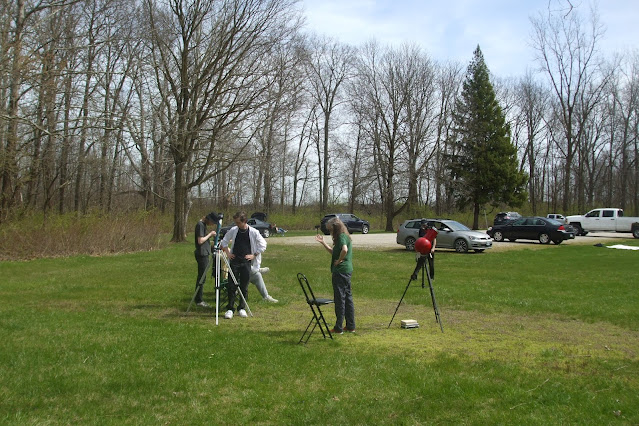It was a very successful trip to Ohio to view totality. We were able to experience 3' 40" of totality, an experience never to be forgotten. We braved horrendous traffic both ways, not getting home until 11:20 pm. We left home at 9:15 am that morning. We aimed for a small town (Tiffin), but on arrival it seemed to be nothing but a circus event, with preachers bellowing, people getting married, loud music blasting from a live band, and general overcrowding. So we returned north 10 miles to Wolf Creek Park, and found our paradise location for this important day. First some facts. The park was a medium sized picnic grounds, with a large open grassy area. We had a large picnic shelter for shade, but set up our Edmund Astroscan scope (4 1/4" mirror) in the open. We have a solar filter that fits over it at the front. Our latitude was 41 17' N, and the longitude was 83 10' west. We used three eyepieces giving 16x, 18x, and 25x.
 Our observing site at Wolf Creek Park, Ohio. Deb checks out sunspots. Our grey VW Golf in behind Deb. The scope is an old but trusty Astroscan from Edmund Scientific.
Our observing site at Wolf Creek Park, Ohio. Deb checks out sunspots. Our grey VW Golf in behind Deb. The scope is an old but trusty Astroscan from Edmund Scientific.The experience of viewing a total eclipse was completely mind-boggling. The plentiful birdsong from the woods ceased suddenly, the afternoon breeze vanished, darkness was nearly total, and very sudden. For 3' 40" we witnessed the bright corona shooting out in all directions from behind the moon, as well as a very large solar flare in the south end. Special glasses are not needed during totality, and would only show darkness. We saw a twilight sky on the southeast and northwest horizons. Light bark on tall poplar trees stood out as if luminous under black light. We could discern light and shadow on the ground right up to the final seconds. Then, suddenly, darkness arrived, the most mysterious kind of dim twilight one could ever imagine. The 'diamond ring' was visible in the telescope just before totality, lasting perhaps 1-2 seconds, accompanied by two 'beads' of light. Others saw the ring with their special glasses. Then came the spellbinding sight of the very active solar corona, accompanied by a sizable and bright flare at the south end. There was darkness, stillness, and a general quiet that became almost overwhelming. All of this was seen and experienced with all normal senses. The telescope showed nothing until the sun reemerged. Venus and Jupiter shone brightly through the thin hazy clouds, Venus ahead of the sun and Jupiter behind it. But even though we were near the centre, and enjoyed a fairly long eclipse time, it was over far too quickly. It seemed as if one minute had passed, instead of almost four.
We were accompanied at our site by three young friends, who remained with us during most of the event, including totality. They were happy to use the Astroscan, and we were happy that one of them, Hayden, was a photographer and physics student. All of the shots of the sun on this page were taken by Hayden Atchison. Through the telescope eyepiece he used his iPhone; for totality shots he used his main camera. I took the daylight ground shots.
There is no doubt that the eclipse was also a hugely spiritual experience. We have had many such experiences in our lifetime, but this one was greatly intensified because of its brevity. Imagine taking the time to listen to all of the Mahler symphonies. Now condense that experience down to 3 minutes and 40 seconds. Imagine carefully studying all of the paintings by Pieter Bruegel the Elder, and condensing all those special moments of revelation and delight into 3' 40". Our climb to the summit of Wheeler Peak in New Mexico took an entire day, but still energizes our spirits years later. Again, condense that emotional, physical, and spiritual event into 3' 40". Then you might have something of the effect (and affect) of viewing a total eclipse in the woodlands of Ohio. It also gave us a tiny sense of just what the Sun actually is--a vast nuclear furnace of a scale that goes well beyond our comprehension.
This event happens to be my 999th logged astronomical event! I began by studying the moon with binoculars in November 1968, and am still an active amateur astronomer. It is also the last entry in my 13th volume of detailed notes recording my observations of the past 56 years. A lucky volume, indeed.
Mapman Mike







.jpg)

No comments:
Post a Comment